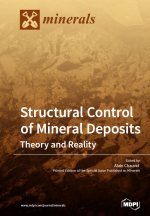Добрый день, Коллеги. Важное сообщение, просьба принять участие. Музей Ферсмана ищет помощь для реставрационных работ в помещении. Подробности по ссылке
Structural control of mineral deposits. Theory and reality / Структурный контроль месторождений полезных ископаемых. Теория и практика
“Structural Control” remains a crucial point that is frequently absent in scientific and/or economic analyses of ore deposits, whatever their type and class, although a selection of references illustrates its importance [1–5]. The case of lode deposits is particularly adapted, but other types, like breccia pipes, stockwork, massive sulphides, skarn, etc., also concern Structural Control. Works on the Structural Control of ore deposits are not abundant in the recent literature, and, as frequently suggested, structural geology often is not sufficiently developed in the exploration programs of many mining camp’s strategies. A few compilations have been devoted to this theme in the last two decades, such as (i) the special publication of the Geological Society of London, concerned with the link between fracturing, flow, and mineralization [6], (ii) the review of the Society of Economic Geology, devoted to Structural Control [7], (iii) a special publication of the Geological Society of London, looking to study the genetic link that can exist between mineralization and orogenic domains [8], and finally, (iv) a special issue of the Journal of Structural Geology, devoted to the application of Structural Geology in mineral exploration and mining [9]. In addition to these four compilations, only a few publications have been concerned with this theme, and most of them are dated before the year 2000. These publications mostly concerned vein internal infilling textures [10,11], the vein formation model, with the contribution and controversy of the crack seal, dissolution-precipitation, diffusion, and seismic-valves mechanisms (e.g., [12–16]). In his review, Chauvet [17] discussed of some of these concepts, in order to highlight the role and the significance of pre-existing structures in the formation of vein-style deposits. <...>
Structural Control of Ore Deposits: The Role of Pre-Existing Structures on the Formation of Mineralised Vein Systems
Structural Control on the Formation of Pb-Zn Deposits: An Example from the Pyrenean Axial Zone
Structural Controls of Ore Mineralization in a Polydeformed Basement: Field Examples from the Variscan Baccu Locci Shear Zone (SE Sardinia, Italy)
Multi-Stage Deformation of the Khangalas Ore Cluster (Verkhoyansk-Kolyma Folded Region, Northeast Russia): Ore-Controlling Reverse Thrust Faults and Post-Mineral Strike-Slip Faults
Tectonic Control, Reconstruction and Preservation of the Tiegelongnan Porphyry and Epithermal Overprinting Cu (Au) Deposit, Central Tibet, China
The Jbel Saghro Au(–Ag, Cu) and Ag–Hg Metallogenetic Province: Product of a Long-Lived Ediacaran Tectono-Magmatic Evolution in the Moroccan Anti-Atlas
Fault Zone Evolution and Development of a Structural and Hydrological Barrier: The Quartz Breccia in the Kiggavik Area (Nunavut, Canada) and Its Control on Uranium Mineralization
Structural Control on Clay Mineral Authigenesis in Faulted Arkosic Sandstone of the Rio do Peixe Basin, Brazil
Structural Controls on Copper Mineralization in the Tongling Ore District, Eastern China: Evidence from Spatial Analysis
The Hajjar Regional Transpressive Shear Zone (Guemassa Massif, Morocco): Consequences on the Deformation of the Base-Metal Massive Sulfide Ore




